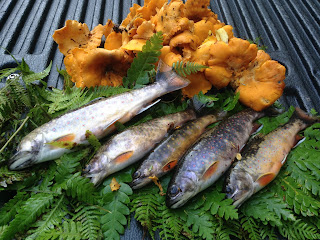In June I
like to drive the back roads of Chittenden and Addison Counties with a Vermont Gazetteer
in my lap and proceed from one waypoint to another checking for the tell-tale
bolting stalks of wild asparagus, marking them with an “x” on my map. I have
been doing this for several years now and have trained my eye to look for
ditches, fences and sunny shoulders where, most frequently on the western side
of the road, a few standing plants have passed and begun to branch out into the
frilly dill-like leaves that indicate a hospitable environment for this, my
favorite wild edible.
Summiting
a small hill east of Snake Mountain, I spot them in the distance. The elusive,
magical wild asparagus. I slow down and check my rear view mirror for
interlopers. I am on a dirt road and no one else is behind me. I jump out of
the truck, leap over the bank into the ditch, and begin scouring the long
grasses that surround the beefy stalks. Score! One, two, three…four nice 1/2”
round stalks with the tiny buds still clinging tightly to the main stem. I spot
four more but let them be, to mature in another year. I hop back in the truck
and mark the spot with my “x” and head north to the river in search of
fiddleheads.
Most fiddleheads
have passed, except in a few shady riparian riverbanks. These delicious wild
edibles are found along river and stream shorelines, where they can sprout up
through the root balls surrounded by sandy soil leftover from the late winter
snowmelt. The tiny sprouts are tightly bundled and wrapped in a brown
paper-like sheath. The inner edge of the spine is concave and snaps off
crisply. Sautéed in butter or olive oil with some finely minced garlic or
shallots the flavor is as close to rapture as a vegetable can attain. I
describe their taste as a cross between a snappy asparagus and an earthy
artichoke. Beside a few freshly caught brook trout, garnished with fresh dill
and a slice of lemon, there is no finer wild feast that can be had by man or
beast.
Wild
leeks, colloquially known as “ramps” were harvested earlier, during turkey
season. I find them consistently on western facing slopes in wet soil and rocky
terrain. The leaves are broad and somewhat waxy terminating to a rounded point.
This year, as I sat waiting for a gobbler to walk into my calling, I was
overcome with the strong fragrance of these edibles that were discovered by the
Abenaki and named “Winooski” meaning “wild onion.” After taking a nice young
jake, I sat down in the middle of the field of ramps and
picked a vest full of succulent specimens.
Here I wish to note that I employ
sustainable harvest principles for all my foraging and never take more than
1/10th of the population. In the case this year, I was surrounded by a half
acre of mature “Winooski” and felt fine about taking five pounds. When I
arrived home, I sprayed them off and cleaned them by clipping off the white
root and the green leaves and separating them. The white bulbs, roasted with
olive oil and sea
Now it
is time to head into the high mountain streams in search of one of earth’s most
beautiful treasures, the brook trout. Although a salmonid, the brook trout is
actually not a trout at all, but a char. The Latin name salmo fontanalis means “of a spring or fountain” referring to the cold
clear water that it requires as habitat. It is Vermont’s state fish and is one
of the true signs that a steam or river is clean and well oxygenated. The daily
limit on these colorful piscatorial delights is, at this time, 12 per day. Here
I will make my opinion, albeit unpopular with the hook and bullet crowd, heard
now. I am against this creel limit.
There is no need to take more than three or
four of these majestic fish (I believe in catching my own fish rather than
purchasing them at the supermarket where they have been farm raised on a diet
of chemically treated pellets that change the color of their flesh) for a meal.
And even then, with respect to the specific pool’s population, I would not
return again that season. I believe that a six fish daily limit is more than
sufficient to appease those who wish to catch dinner and those who would like
to feed a party of two. As my friend, Chris Thayer says, “brook trout and orange
juice is proof of a Higher Power.” Just look at the colors – green and brown tiger
stripes on the back, red dots with blue halos on the flanks and orange pectoral
and pelvic fins tipped in white.
On a
good day in June, I will spend the entire daylight hours driving the back roads
in search of fiddleheads, wild asparagus, ramps and maybe a few chanterelles to share
the plate with a few freshly caught brookies.
As a
society we have moved away from providing for ourselves from the earth and
purchase most of our food in a store under fluorescent lights, wrapped with
plastic wrap in a Styrofoam container. However, June reminds me that the Great
Spirit still provides us with all we need if we only take the time to worship
nature and learn from our ancestors.





I love brookies cooked over coals on a grill. Roll them off and eat with you hands. Combined with fiddleheads and a bit of white wine and you have a meal fit for a king!
ReplyDeleteBradley - do you have any luck finding morels over your way? chanterelles should be coming in a few weeks in my neck of the woods.
Bradley,
ReplyDeleteVery nice indeed. Makes me ache for the VT woods and hollows.
Thank you,
jim